Studio Staples: Use a Viewfinder to Discover Rhythms in Nature
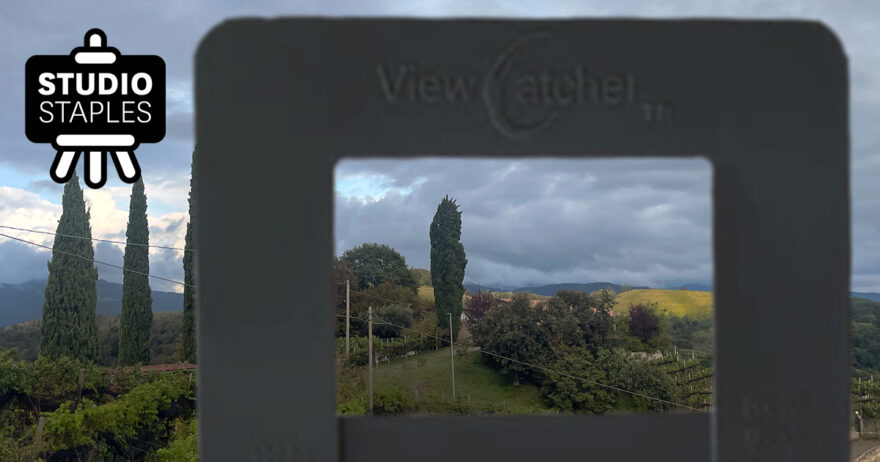
We’ve all stood before a breathtaking vista, compelled to translate the experience into a painting only to be overwhelmed by the sheer complexity of it all. How do we move beyond just copying details to crafting a composition that works as a painting? The answer often lies in simplifying, structuring, and finding the scene’s foundation. And for that, one of the most useful tools – a true studio staple, whether you’re actually in the studio or out in the field – is the basic viewfinder. This simple frame isn’t just for looking at the landscape; it’s for actively designing, using it to help discover the underlying rhythms and structural bones that are key to crafting compelling compositions.
Think of your viewfinder – whether adjustable plastic, basic cardboard, or just your hands – as your primary filter for translating the chaos of nature into manageable and composable shapes. Before you even think about specific techniques or color palettes, using the viewfinder is the crucial first step in analysis. Looking through this isolated window helps when identifying basic geometric shapes – the triangle of a distant mountain peak, the rectangle of a field, the circle or oval of a pond – by blocking out the overwhelming peripheral information. You’ll also more easily spot the abundant organic shapes – the irregular, flowing contours of tree masses, clouds, or meandering stream banks. Just as importantly, the viewfinder also makes it easier to identify negative shapes – the shape of the sky between two trees, or the silhouette of the land against the horizon. Recognizing these fundamental shapes is the first step to understanding the structure of your potential painting.

Now, let’s layer in some core compositional ideas: rhythm, movement, and balance. Think of rhythm in art much like you think of it in music. It’s about repetition, pattern, and flow. In a landscape, rhythm might be found in the repeated verticals of tree trunks, the undulating curves of rolling hills, the spacing of clouds, or the pattern of shadows marching across a field. Again, your viewfinder is invaluable here. By sliding it across the scene or adjusting its opening, you can isolate different sections and more clearly perceive these repeating elements and visual beats. These repetitions aren’t usually perfectly identical, which adds interest, but they create a cadence that resonates through the composition you’ve framed.
This rhythm is what generates movement. Our eyes naturally follow repeating elements and patterns. A line of fence posts receding into the distance pulls your gaze inward. The S-curve of a river guides the eye smoothly through a composition. The staggered placement of trees can create a visual skip-and-jump across the canvas. By identifying these rhythms (often first spotted through your viewfinder) and then choosing how to emphasize them in your composition, you actively direct how viewers experience your painting, creating a pathway for the eye to travel.
Ultimately, rhythm and movement contribute to balance. Whether you’re aiming for the formal stability of symmetrical balance or the more dynamic, nuanced equilibrium of asymmetrical balance, the way rhythms are distributed across your picture plane plays a crucial role. A strong rhythm on one side might need a counterpoint – perhaps a large, quiet shape or a point of high contrast – on the other to achieve a sense of visual harmony within the frame you’ve selected.
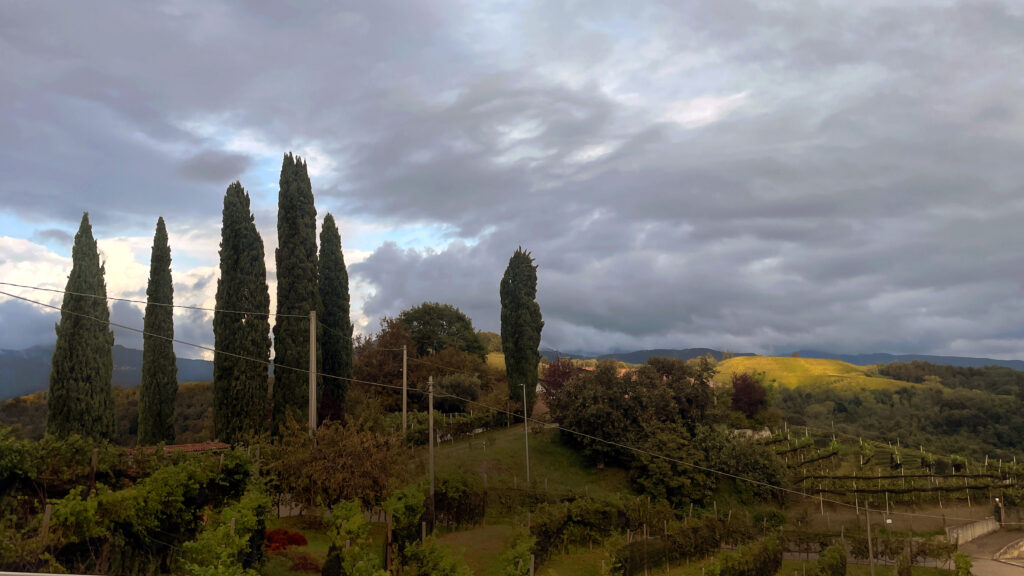
Creating Rhythm: Savorgnano Hills
Let’s explore this concept further using a reference image taken from a recent trip to Northern Italy. This scene presents us with a range of opportunities to explore shapes and rhythms. When I took the original reference (above), I intentionally took a wide shot, allowing me an opportunity to crop for a more dynamic composition in the studio. In the image below, you can see how the various trees and vineyards have been simplified into basic shapes, and how those basic shapes are repeated throughout the landscape to create a variety of visual rhythms.
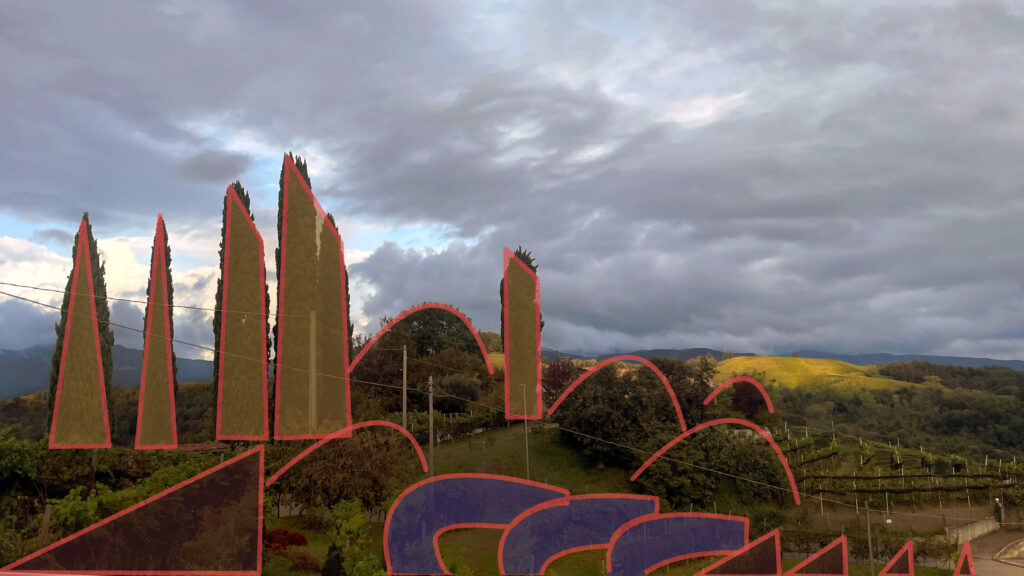
Here, I’ve simplified a variety of forms into simple shapes and identified repetitions that suggest visual rhythms
Thumbnail Sketches
So, how do we harness these concepts practically? Bring out your viewfinder again and create a variety of thumbnail sketches. Thumbnail sketches are great exercises in themselves, as well as being invaluable for establishing your focus and direction before committing to a larger piece. The main thing about thumbnails though, is that the process is not about detailed drawing; it’s about designing.
Here’s the process:
1
Observe, Frame, and Identify: Look intently at your chosen landscape, using your viewfinder to scan and isolate different parts. Actively search for those rhythms we discussed – repeating lines, shapes, intervals, value patterns. Squinting while looking through the viewfinder further simplifies the scene into major masses and movements. Adjust the viewfinder’s aspect ratio (making it more square, a narrow vertical, or a wide horizontal) to see how the rhythms change within different formats.
2
Prepare Your Sketch Space: On a sheet of paper (or in your sketchbook), draw several small rectangles replicating the various aspect ratios you explored with your viewfinder. Try some horizontals, some verticals, maybe even a square format. This directly translates your viewfinder explorations onto paper.
3
Sketch Rapidly, With Variation: Now, within each rectangle, quickly sketch the essence of the scene as framed by one of your viewfinder explorations. Use simple lines and basic value masses (light, medium, dark). Don’t get bogged down in detail. The goal is to capture different compositional possibilities based on the rhythms you identified and framed. Vary the emphasis in each thumbnail as you consider specific ways to frame the scene. In one sketch, emphasize the horizontal sweep. In another, focus on the verticals. In a third, perhaps the pattern of light and shadow is your area of focus. Push and pull the elements you saw. Exaggerate a curve. Simplify complex areas. Ask “what if?” with each little sketch, always relating back to what the viewfinder helped you see and isolate.
4
Analyze: Create at least five or six thumbnails, ideally more, reflecting different viewfinder framings. Then, stand back and look at them together. Which ones feel the most dynamic? Which best captures the feeling or the specific rhythmic idea you explored? Which has the most compelling movement and sense of balance?

The viewfinder acts as your focusing lens, helping you cut through the clutter to see the underlying structure and rhythms. The process of creating thumbnail sketches then becomes your compositional playground, where you test the ideas the viewfinder helped you discover. It’s a low-stakes way to translate observation into design, make informed decisions, and visualize your finished painting before you invest significant time and materials. By consciously using a viewfinder to identify rhythms and then actively exploring how different framings express those rhythms through thumbnail sketches, you move beyond simply trusting your initial response to the subject. You begin to interpret it in your work, describing a stronger sense of structure, movement, and personal vision. Give this combined approach a try – you might be surprised how this focused exploration unlocks the hidden potential in your work.

Meet the Artist
Scott Maier is an artist, instructor, and a content contributor to artistsnetwork.com. He’s an adjunct instructor at Rocky Mountain College of Art and Design, as well as the author of the instructional art book See, Think, Draw: An Easy Guide for Realistic Drawing and Beyond.
From Our Shop
 Artists Network Membership - 1 Month
Artists Network Membership - 1 Month 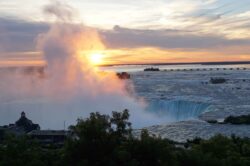 Breakthrough Paint Along: Where Mixed Media Combine Together
Breakthrough Paint Along: Where Mixed Media Combine Together  Paint Along 127: Paint the Motion of the Sea
Paint Along 127: Paint the Motion of the Sea 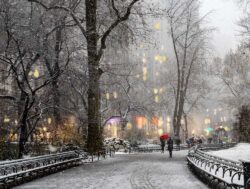 Paint Along 126: Simplify Your Landscapes with a Limited Palette
Paint Along 126: Simplify Your Landscapes with a Limited Palette 


















Join the Conversation!